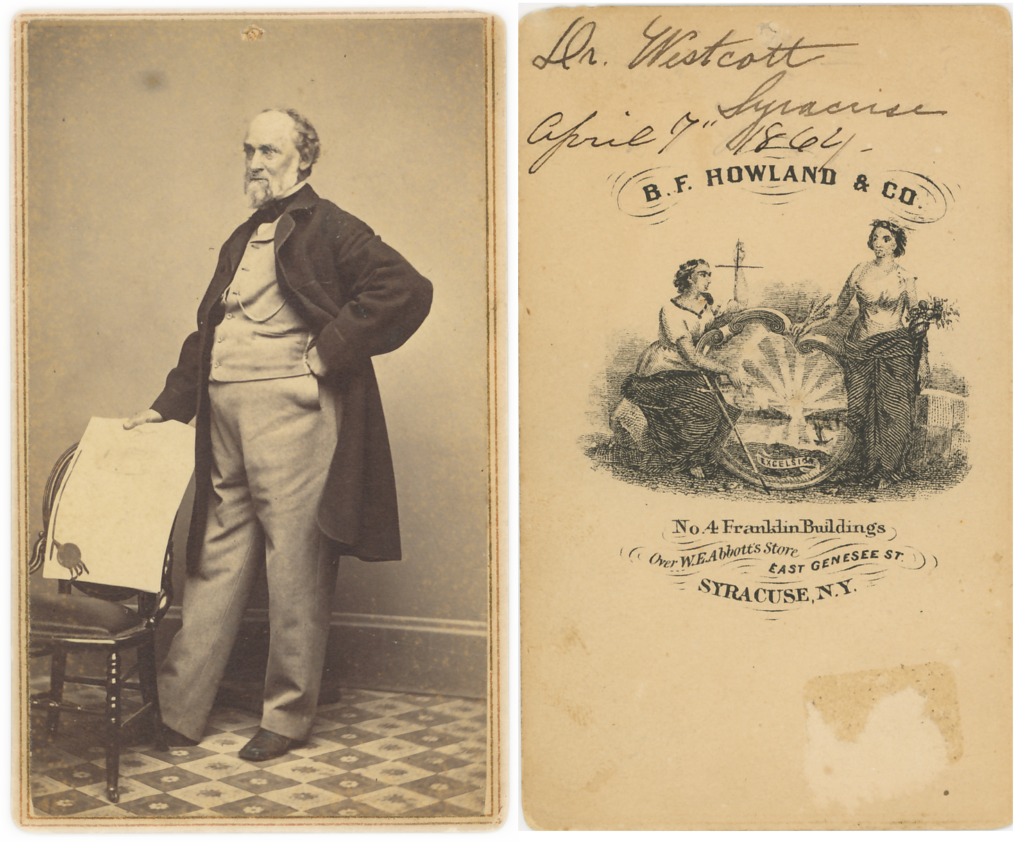
Amos Westcott (1815-1873) stands with his 1840 diploma from Albany Medical College in this 1864 photocard from the B.F. Howland Studio in Syracuse, New York
Amos Westcott, the father of authors Edward Noyes Westcott and Rev. Frank Nash Westcott, was born on April 20, 1815 in Truxton, New York, the eleventh of the fourteen children of Gorton Westcott and Waity Knight. Amos was a descendant of Stukely and Juliana Westcott in the seventh generation (Amos Westcott7, Gorton6, Reuben5, Amos4, William3, Jeremiah2, Stukely1). Like his two sons, the story of Amos is one of great accomplishment and fame marbled with profound sadness and despair.
In 1835 Amos was one of the first four graduates of Rensselaer Polytechnic Institute; he then began the study of medicine at the Albany Medical College, from which he was graduated in 1840. He moved to Syracuse in 1841, where he began his dentistry practice.
Amos and his first wife, Clara Babcock (1819-1855), had three children: Watts, Clara and Edward Noyes. Watts and Clara died in infancy. Their mother died on February 6, 1855, at the age 55. Several years later Amos married Clara Nash (1832-1891). They had two children: Margaret, who married Austin Muzzy of New York City, and Frank Nash Westcott, the second author in the family.
In “The Westcotts and David Harum,” Richard Case writes:
Amos would be known as the country’s “first dentist,” apparently an honorific rather than a chronological title. He is reputed to have helped to move dentistry out of the “barber chair” era. He improved then-unsatisfactory dental tools, wrote books on oral surgery, and was a founder of the New York College of Dental Science in Syracuse, the fifth institution of its kind in the United States. Dr. Westcott used chloroform, improved false teeth, and invented a new kind of butter churn and a burglar-proof key fastener. (Read the full article.)
A well-respected member of the community, Amos served as Mayor of Syracuse in 1860. In 1869, he purchased a quarter share of the Cardiff Giant, which was debunked three months after the ten-foot petrified man was “discovered” on Stubb Newell’s farm in Cardiff, 14 miles south of Syracuse. Whether the investment in “America’s Greatest Hoax” was a momentary lapse of scientific judgment or just plain fraud, it seemed out of character for Dr. Westcott. Roscoe Whitman’s sources for “Tragedies and Hoax of Some Westcotts” (1945) report that the hoax was entirely Dr. Westcott’s doing:
It was Dr. Amos Westcott who conceived the hoax of the Cardiff giant, one of the oddest impositions ever perpetrated. With a horse-trading friend of Homer, N.Y., they are said to have stirred up an argument as to whether giants ever really existed. In support of his contention that they did, Dr. Westcott pointed to the Biblical statement that “there were giants in those days.” Two years are said to have been spent in the preparation of the giant figure carved from stone, constructed in such a way that doubt might be raised whether it was a fossilized human being or a prehistoric sculpture. It was rubbed with sand until the features were partly obliterated, pieced with what looked like wormholes, bathed in sulphuric acid, and given a course of treatment that gave it the appearance of great age. The figure was ten feet, four inches tall, weighed 2,990 pounds and had shoulders more than three feet from point to point; it was then planted on a farm at Cardiff, a small farming community in Ononadaga County, N. Y. It was dug up by a third party and its “discovery” created much interest. It was exhibited in the Geological Hall at Albany in December, 1869, and attracted widespread attention. Dr. Westcott and his accomplice derived much amusement from the exhibitions of the Cardiff Giant until, finally, the hoax was revealed.
In a 2018 profile in New York Dental Association News, Dr. William James Maloney described Amos’ final years:
During his life, Westcott had been known as a man of strong will and countenance, constantly writing and experimenting in an effort to bring pride and grand stature to his beloved profession of dentistry. However, by 1871, his health began to decline. It was thought that a trip to Europe could be a cure for his poor health. But the trip did not restore his well-being, and Westcott returned home absent of hope. His once sprightly frame and radiant smile were replaced with a bent posture and a face given to expressions of anxiety and pain. The citizens of Syracuse and the international dental community were saddened to awake on a quiet Sunday morning, July 6, 1874, to the shocking news that Dr. Westcott had taken his own life by shooting himself through the neck. (Read the full article.)
This was not the first suicide among the descendants of Gorton Westcott: Amos’ brother George Nelson Westcott committed suicide years earlier. Nor was it the last: Amos was followed by children Margaret Muzzy (1911) and Frank Nash Westcott (1915), and grandson Phillip Westcott (1929).
Dr. Maloney concluded his profile with this assessment of the country’s first dentist: “Dr. Amos Westcott was viewed by his contemporaries as a man who gave freely of his knowledge to his colleagues and a man of logic with an aggressive nature and immense energy. Today, we remember him with gratitude for laying the solid foundation for dentistry in New York State.”
Sources: Betty Acker, “Edward Noyes Westcott, Author of David Harum” (2000); Ancestry.com; Richard Case, “The Westcotts and David Harum” (1973); Findagrave.com; Edna Lewis, The Westcott Family Tree (2000); New York State Dental Association; Roscoe Whitman, “Tragedies and Hoax of Some Westcotts” (1945).
